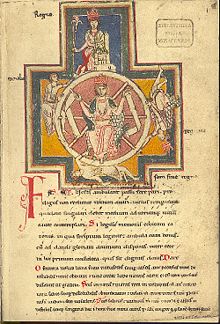|
|||
|
Philatelia.Net / The literature / Plots / The directory «Plots»«Carmina Burana»Carmina Burana, also known as the Burana Codex, is a manuscript collection, found in 1803 in the Bavarian monastery of Benediktbeuern, and now housed in the Bayerische Staatsbibliothek in Munich. The 119 leaves of the original collection contain 228 poems compiled by three different scribes. The Latin title Carmina Burana or Songs of Beuern was assigned by Johann Andreas Schmeller in 1847. Beuern (from Old High German bur = "small house") refers to the abbey of Benediktbeuern founded in 733 in the foothills of the Bavarian Alps about thirty miles south of Munich. Subsequent research has shown that the manuscript did not originate there; Seckau Abbey is regarded as a likely earlier location. The pieces are almost entirely in Ecclesiastical Latin meter; a few in a dialect of Middle High German, and some with traces of Old French. Many are macaronic, a mixture of Latin and German or French vernacular. They were written by students and clergy about 1230, when the Latin idiom was the lingua franca across Italy and western Europe for traveling scholars, universities and theologians. Most of the poems and songs appear to be the work of Goliards, clergy (mostly students) who sent up and satirized the Church. The collection preserves the works of a number of poets, including Peter of Blois, Walter of Châtillon, and the anonymous one referred to as the Archpoet. The collection is divided into six sections:
The first section, thought to be of religious songs, is now lost and there is no record of the missing poems. Therefore it is impossible to trace the manuscript's existence before its mutilation, since manuscripts were usually catalogued by their opening line. The final section was not originally part of the manuscript and is a scholarly reconstruction of some of the poems where differences and emendations have been found buried underneath other texts. Many of the religious songs and several of the love songs and drinking songs are accompanied by neumes that suggest melodies. Some of the poems have also had corresponding melodies discovered in later manuscript sources. Between 1935 and 1936 German composer Carl Orff set 24 of the poems to new music, also called Carmina Burana. The most famous movement is "Fortuna Imperatrix Mundi (O Fortuna)" (Fortuna meaning Fortune in Latin, as well as a Roman goddess). Orff's composition has been performed by countless ensembles. German Federal Republic, 1995, Characters from «Carmina Burana» Advertising: |
|||
© 2003-2024 Dmitry Karasyuk. Idea, preparation, drawing up
|

